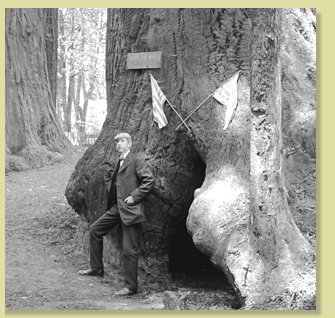 |
Robbins-Mills Collection of Herbert Wendell Gleason Photographic Negatives, 1899-1937 Concord Free Public Library — Special Collections |
BIOGRAPHY
 Herbert Wendell Gleason (1855-1937)—American landscape photographer, minister, naturalist, writer and lecturer—was born June 5, 1855 in Malden, Massachusetts to Herbert and Elizabeth (Upton) Gleason. He was the oldest of five children. Gleason graduated from Malden High School in 1873 and from Williams College in 1877. At Williams, he was a member of Phi Beta Kappa, editor of the Atheneum, gave a Commencement oration, and won prizes in German and natural history. He received the BD degree from Andover Theological Seminary in 1881.
Herbert Wendell Gleason (1855-1937)—American landscape photographer, minister, naturalist, writer and lecturer—was born June 5, 1855 in Malden, Massachusetts to Herbert and Elizabeth (Upton) Gleason. He was the oldest of five children. Gleason graduated from Malden High School in 1873 and from Williams College in 1877. At Williams, he was a member of Phi Beta Kappa, editor of the Atheneum, gave a Commencement oration, and won prizes in German and natural history. He received the BD degree from Andover Theological Seminary in 1881.
In March, 1883, Gleason moved to Minnesota to begin his Congregational ministry at Pelican Rapids (1883-1885), and in the same year, married Lulie Wadsworth Rounds (his childhood sweetheart). He was ordained on March 7, 1887, while serving as pastor for the Como Avenue Congregational Church in Minneapolis (1885-1888). From 1889-1899, he was editor of the Northwest Congregationalist (later known as The Kingdom). Gleason left the ministry in 1899 and devoted the rest of his life to photography and lecturing.
After returning to Massachusetts in 1899, Gleason began making routine trips to Concord and the surrounding area to photograph Thoreau sites. Using Thoreau’s journals as his starting point, he meticulously located and identified the many places to which Thoreau had referred to by his own names. Gleason’s research sources included the 1852 and 1856 Walling maps of Concord and the extensive collection of manuscript Thoreau surveys in the Concord Free Public Library. He also talked with Concord residents (Edward Waldo Emerson, John Shepard Keyes, and Frank Sanborn) who knew Thoreau. Gleason used the information gathered in his research to prepare the map of Thoreau localities included in Volume 20 of the 1906 Walden and Manuscript Editions of Thoreau’s writings. Gleason's photographs were used to illustrate the twenty-volume 1906 editions and Through the Year with Thoreau (1917).
Gleason's work for the National Park Service was a major aspect of his career as a photographer. He was appointed an Interior Department Inspector by Stephen T. Mather, the first director of the National Park Service established in 1916. Gleason photographed the nation's early national parks and wilderness areas under consideration for national park status by Congress. Using material gathered on his trips, Gleason gave lectures to publicize the national parks and promote the need for further protection of natural areas. His dedication to nature was passionate. In a letter to John Muir (December 18, 1907) Gleason wrote: "I told an audience in Los Angeles that I thought it ought to be made a capitol offence to cut down a Sequoia..."
Gleason's active professional life included his friendship with Luther Burbank whose horticultural experiments he photographed and presented in illustrated lectures. He illustrated the writings of John Muir. In addition to photography, Gleason gave numerous illustrated lectures on a variety of topics including the national parks, horticulture, traveling in America, and nature study. During the 1930s, he was one of the official photographers for the Arnold Arboretum.
Gleason died on October 4, 1937 in Boston and is buried in the Rounds family plot in Forest Dale Cemetery, Malden, MA. His wife Lulie died in 1934. The Gleasons had no children. Gleason was a member of the Sierra Club, the Appalachian Mountain Club, and the Massachusetts Horticultural Society.